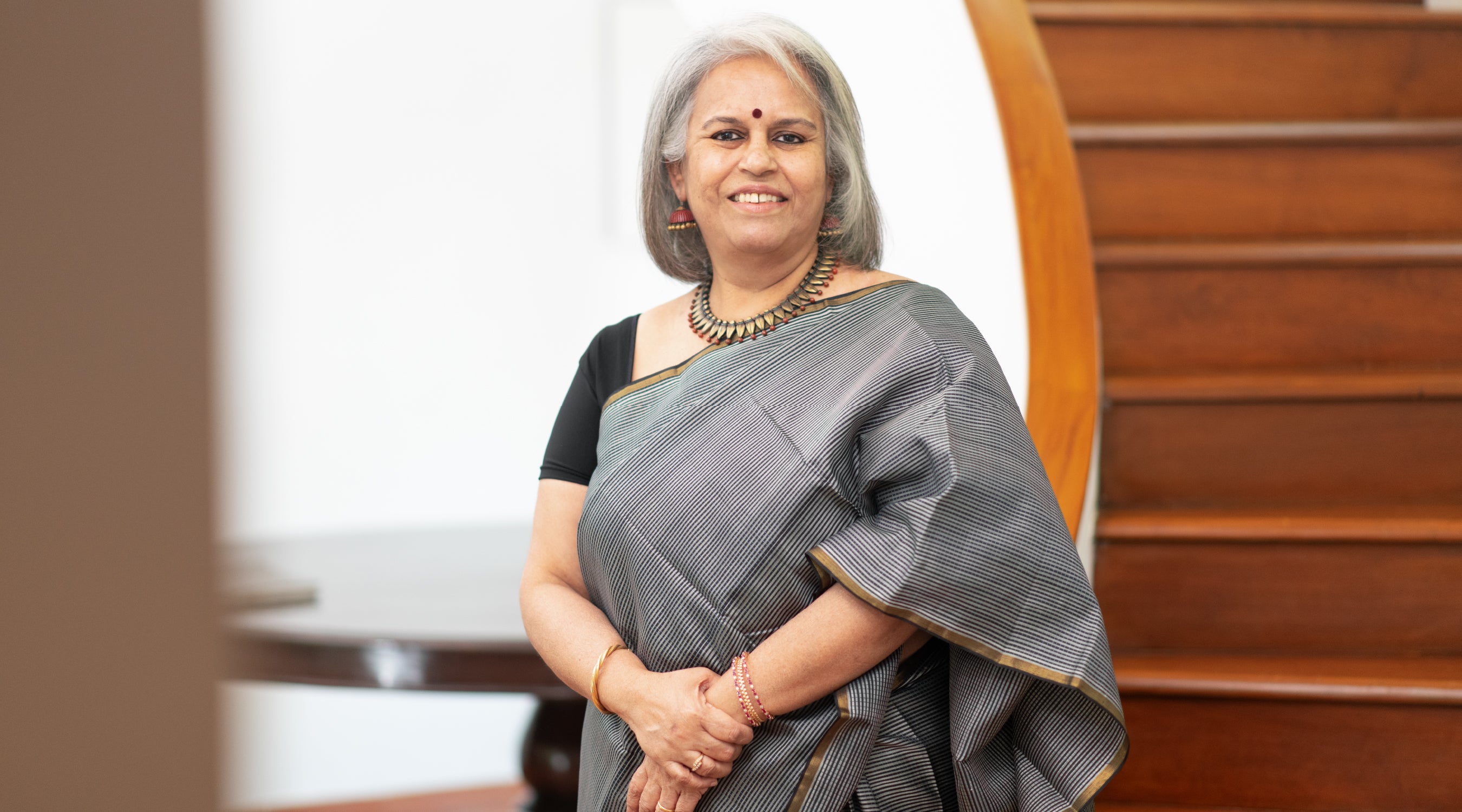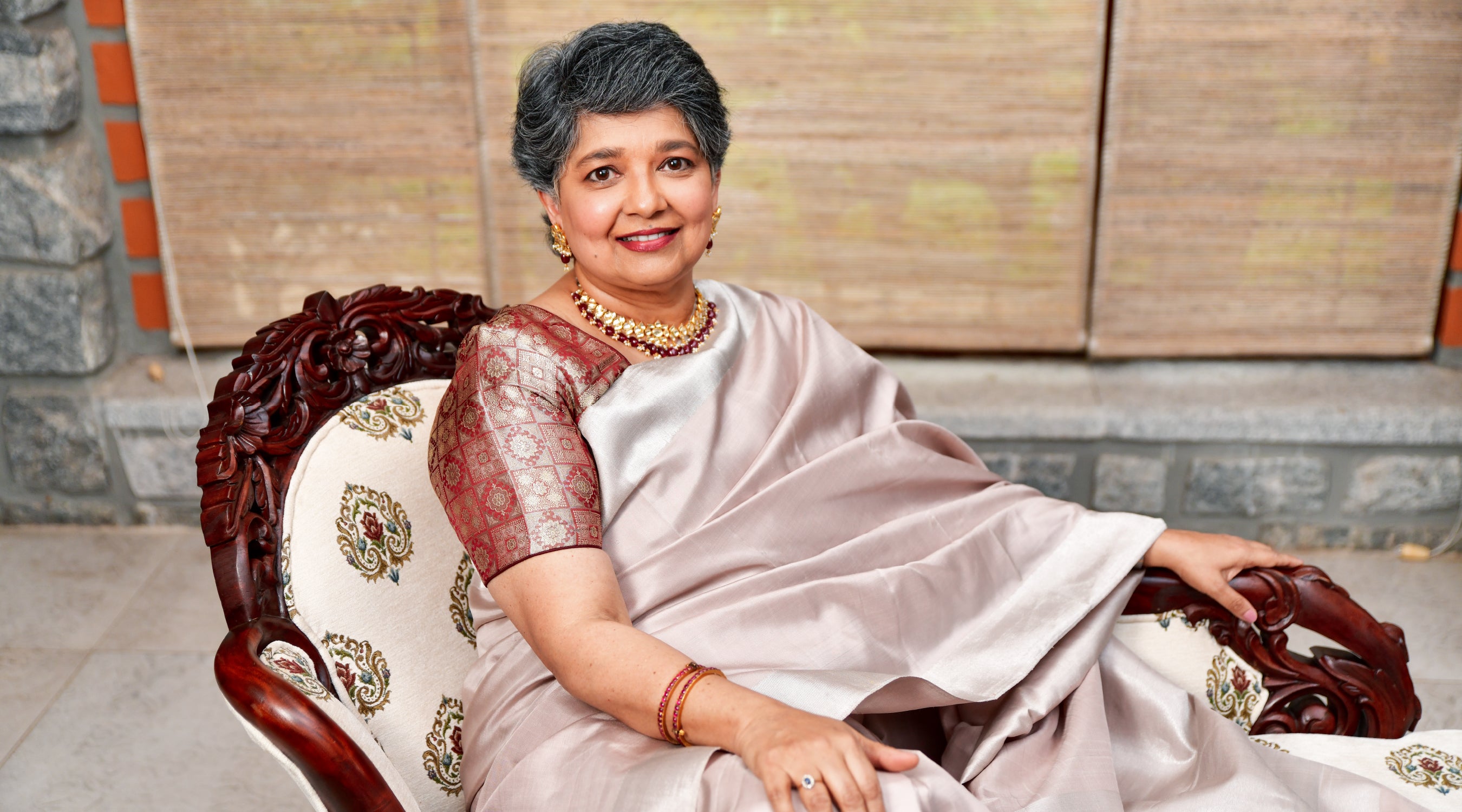KANAKAVALLI VIGNETTES : Dr. Anuradha Ganesan - Inspired, Inspiring

Dr. Anuradha Ganesan, Kanakavalli’s January Vignette, works in the field of health and education, and is committed to ideas of service, community and working for a cause greater than the self. In conversation with Aneesha Bangera for The Kanakavalli Journal, Dr. Anuradha reminisces about her idyllic childhood spent in South India, with visits to her mother’s hometown in Ipoh, Malaysia. Deeply influenced and inspired by her parents, their commitment to hard work and the values they lived by, she strives to continue their legacy in varied ways. Finding joy in her work with young people, Dr. Anuradha believes that beauty lies in strength. For her, the sari feels like home no matter where she may be. Taking time out of a busy schedule, Dr. Anuradha browses the Kanakavalli repertoire to curate a selection of kanjivarams that reflect her love for the craft.
Excerpts from the conversation below…
Inspired, Inspiring
Tell us about your childhood and your most precious memories of growing up.
I have cherished memories of my childhood—living in a huge joint family, surrounded by lots of people. I was one of several siblings and cousins who grew up together in a large house. We entertained ourselves playing police and robbers and hopscotch, staging plays, organising tea parties, and swinging high into the skies. I spent my childhood in Madras, Madurai and Coonoor, and was fortunate to spend my holidays both in my father’s hometown of Ramnad as well as my mother’s hometown of Ipoh, in Malaysia.

Above (left to right): Dr. Anuradha as a child with her siblings and grandfather on a visit to her mother's hometown of Ipoh, Malaysia; Playing with her siblings in Coonoor where she spent a part of her childhood.
While studying in Coonoor, I spent my days on the family estate, exploring streams, orchards and gardens, chasing butterflies and sparrows, trying to catch tadpoles and fish, all with a motley bunch of cousins. We found so much joy in the beautiful outdoors. In Madurai, we were steeped in the culture of the temple town and its traditions. I remember wearing silk paavadais and malligapoo in my hair on Fridays and for special occasions. We would welcome guests into our home with palms folded in vanakkam, and were expected to follow several traditions.
Spending my holidays between a village in Tamil Nadu and a city in Malaysia meant I was exposed to very different ways of living. One moment I’d be getting a ride on a bullock cart, and the next I’d be on a plane to Singapore or Malaysia. While at home in India, we were always travelling—our parents would pack us into a car and we’d drive to Ooty, Kodaikanal, Courtallam, Mysore, and many, many other places. There was never a dull moment, and it was an idyllic childhood.

Above (clockwise from top left): Dr. Anuradha as a child dressed up for Navarathri celebrations; Dr. Anuradha (on the left) and her sister dressed as Radha and Krishna for Krishna Jayanthi; An old family portrait of Dr. Anuradha, her parents and siblings; With two of her siblings as children.
What are the ways in which your parents have inspired and influenced you? Tell us about your family and the ways in which you find strength in their personalities and achievements.
One of my most vivid memories of my father is of when I was a child in his father’s village. There was a big pond by a temple where all the local children would bathe. While swimming one day, I suddenly realised I’d gone in too deep, but before I could even start to panic, I felt two strong hands envelop me and lift me up above the water. For me, this epitomises what my father means to me—he was always my hero, and he made me feel as though I could conquer the world.
My father was a powerful orator—when he spoke, people were mesmerised by his eloquence and passion. He had a flair for Tamil literature and wanted to spread the message of the Thirukkural, which he lived by. My paternal grandfather was a great humanitarian and Gandhian, who was also religious. Both he and my father would never refuse anyone who came to them for help. My father promoted entrepreneurship as well as social causes, and this is his legacy. My family, husband and I try to continue his work in different ways.

Above (left to right): Dr. Anuradha, her grandmother and family at the release of the book of her father's writings; With her father, her hero and inspiration.
It is only after my father passed away that I began to read his books and writings, and recognised the depth of his knowledge and the passion with which he promoted the values he believed in. His work inspired me to start a literary club for Tamil literature with interested students and faculty, and this has taken off quite well. After his passing, my siblings and I put together the video and audio recordings of his speeches, and released a book compilation of all his work.
My mother has always been very active socially. She runs a school in Madurai, and started one of the first book fairs in Madurai, which became an annual affair. Both my parents loved to read and our home was always filled with books. My siblings and I carried books everywhere we went, including to the dinner table! Both my parents were also very active in the Rotary Club, and I was exposed to the organisation and its activities from when I was very young. The idea of service to a greater cause was instilled in me very early on.

Above: Dr. Anuradha with her mother, who inspired her with her dedication to social causes.
After I got married, I moved to Chennai and worked with my husband and his family in running educational institutions that were founded by my father-in-law 40 years ago. My husband’s parents always had a strong commitment to the community around them. My father-in-law set up hospitals to cater to the poor, in addition to various colleges, medical college hospitals and other educational institutions. My mother-in-law is a very capable administrator who supports several people in a very unassuming way, and manages responsibilities very efficiently.

Above: An old photograph of Dr. Anuradha with her parents-in-law, who had a strong commitment to their community.
I am constantly inspired by every single member of my family—by their dedication to work and commitment to their values.
Ever since I was a young child, I have been surrounded by people who gave me a very grand vision of life and constantly inspired to become a better version of myself. Being wholly committed to work and social causes became the norm for me, and as a result I’ve always had very high expectations of myself and those around me. I’m rarely satisfied, and always want to push myself further. I also surround myself with people who inspire me. Having these strong role models to look up to has made me want to do something in service to the larger community, and this is reflected in my work with the Rotary Club as well as outreach programmes we organise with students.
After my father-in-law passed away, my husband took over the reins of the organisation, and I work along with him in managing the institutions. Although we work together, we both believe that a clear demarcation between work and personal life is key for harmony at home!

Above (clockwise from top left): A recent family photograph with Dr. Anuradha dressed in a Kanakavalli kanjivaram; Dr. Anuradha with her husband and son in Prague; Posing with her husband; With her two children, who she describes as "self-driven, independent and thoughtful".
We have two children. Our daughter just graduated with a degree in economics and is an independent, intelligent and affectionate young woman, who I find myself seeking advice from on various matters. She is one of the smartest people I know. Our son is a brilliant, hilarious and charismatic tenth grader—I admire his adherence to his values and ethics. I’ve always allowed my children to do what they aspire to and follow their dreams, and am fortunate they are so self-driven.
As a trained medical doctor working in the field of education, what keeps you motivated and passionate about what you do?
I studied medicine, and currently work in the administration of the educational institutions run by the family. I enjoy spending time with young people, interacting with them during community-based and outreach programmes. I truly believe that these activities, beyond academics, enrich our lives in many ways, and I want students to experience the joys of service. Non-formal learning complements their growth, building creativity and innovation.

Above (clockwise from top): Dr. Anuradha and her husband with students of the college during their graduation ceremony; At a Women's Day event in college; Dr. Anuradha at the inauguration of a college Tamil Literature Club in Pondicherry.
As a trained doctor, health and hygiene are foremost in my mind, and I work to build awareness in the community through our students who act as ambassadors to the world. Some of the projects that are close to my heart are sanitation projects with the Rotary, and the building of toilets in villages that we got the students involved in. I love the energy and enthusiasm of the young people I work with; this inspires me to keep going.

Above (clockwise from top): Dr. Anuradha with members of her Rotary Club at an event for their lake renovation project; With Rotarians in Croatia; Dr. Anuradha receiving the Best Chairperson of the Year Award for community service by the Rotary Club of Madras.
Tell us about your love for spaces and architecture, and how this translates into some of your work?
I discovered a love for spaces while we were building our own home. I enjoyed everything from making floor plans to shopping for furniture and art. Whenever I travel abroad, I love visiting palaces, monuments and other ancient places—I get completely engrossed in their beauty and the stories they tell. At our institutions, there is almost always some work going on—new facilities being built or old buildings being upgraded. I am particularly interested in student housing, and how we can make them cheerful and happy places that are also practical and welcoming for young people. I truly believe that a space can have a big impact on one’s experience. For me personally, being somewhere beautiful can inspire me, whether I’m in a garden looking at the moon, or sitting on a balcony watching the sea. At home, we have a favourite nook for our morning cup of coffee, overlooking the garden, that fills me with a deep sense of calm.
How do you define beauty and tradition?
I find great beauty in strength and irreverence—in people forging their own paths in life.

What does the sari—and the kanjivaram in particular—mean to you?
My maternal grandfather was a self-made man, who started a business in Ipoh, Malaysia, selling saris, among other things. Even in a foreign land, he fostered a sense of community, and kept traditions alive for his family. For me, the sari became synonymous with finding home wherever I may be. The kanjivaram was a source of intrigue for me even before I knew the meaning of the word, as I heard it being discussed at my grandfather’s store. Now, the kanjivaram represents the finest craftsmanship to me, and I think of it as an art form unto itself.
I always remember my mother’s and grandmother’s cupboards, stacked with saris, meticulously arranged by colour and occasion. I have always loved the sense of celebration that a sari symbolises.
Tell us about the sari you chose for the Vignettes shoot.
Although my everyday style tends towards muted and pastel shades I have to pick a gorgeous red for special occasions. This was my grandmother’s colour of choice when it came to kanjivarams and it is a tradition I’ve gladly inherited. While browsing for saris at Kanakavalli around Diwali, this one stood out to me, not only for its colour, but for the beautiful motifs that adorn it.

Dr. Anuradha is wearing a gorgeous kanjivaram in vermillion, adorned with gold iruthalai pakshis on the body. The borders have a green selvedge, while the green pallu features Yalis, peacock and geometric patterns all in gold zari.
- Dr.Anuradha Ganesan, in conversation with Aneesha Bangera, photography by Raghuram Vedant.
View Anuradha's accompanying guest curation here.



